
Euploea klugii, the brown king crow or king crow, is a butterfly found in India and Southeast Asia that belongs to the crows and tigers, that is, the danaid group of the brush-footed butterflies family. The species was first described by Frederic Moore in 1858.

Acherontia styx, the lesser death's head hawkmoth or bee robber, is a sphingid moth found in Asia, one of the three species of death's-head hawkmoth. It is very fond of honey, and bee keepers have reported finding dead moths in their hives as a result of bee stings. They can mimic the scent of bees so that they can enter a hive unharmed to get honey. Their tongue, which is stout and very strong, enables them to pierce the wax cells of the beehive and suck the honey out. They are also known to be a pest of yuzu in South Korea, using their tongue to pierce and damage the fruit.
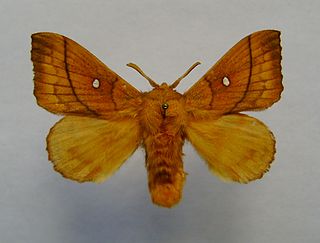
Odonestis is a genus of moths in the family Lasiocampidae described by Ernst Friedrich Germar in 1812. It consists of twenty-two species, which is found in Europe, Russia, Asia Minor, China and Japan.
Meganola brunellus is a moth of the family Nolidae. It is found in Sri Lanka, India, Taiwan, Japan, the Ryukyu Islands, Sundaland, Queensland and the Bismarck Islands. It is an introduced species in Hawaii.

Eterusia aedea, the red slug caterpillar, is a species of moth in the family Zygaenidae. It was described by Carl Linnaeus in his 1763 Centuria Insectorum. It is found in Sri Lanka, India, Nepal, Taiwan, Japan and China.
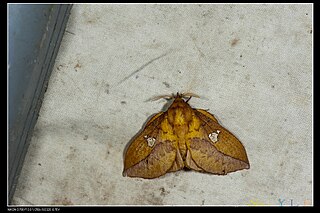
Euthrix laeta is a moth of the family Lasiocampidae first described by Francis Walker in 1855.
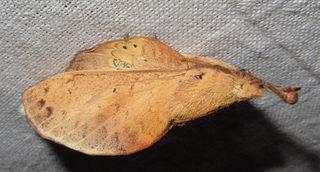
Gastropacha pardale, the brown lapped moth, is a moth of the family Lasiocampidae. The species was first described by Francis Walker in 1855.

Odonestis vita is a moth of the family Lasiocampidae first described by Frederic Moore in 1859. Three former subspecies are now recognized as separate species.
Odonestis ceylonica is a moth of the family Lasiocampidae first described by Tams in 1935. It is found in Sri Lanka and southern India.

Bamra albicola is a moth of the family Noctuidae first described by Francis Walker in 1858.

Caduca albopunctata is a moth of the family Noctuidae first described by Francis Walker in 1857.
Hyperlopha cristifera is a moth of the family Noctuidae first described by Francis Walker in 1863. It is found in Sri Lanka, Laos, Malaysia and Australia. Adult wings are pale brown, sometimes with a number of dark dots near the tornus of each forewing. Forewings with a hooked wingtip, and a cusp on the margin can be found.
Saroba maculicosta is a moth of the family Noctuidae first described by Francis Walker in 1865. It is found in Sundaland, the Philippines, Papuan region to Solomon islands and Sri Lanka.
Artaxa digramma is a moth of the family Erebidae first described by Jean Baptiste Boisduval in 1844. It is found in India, Sri Lanka, Myanmar, Nepal, Java, Borneo, and recently from China.
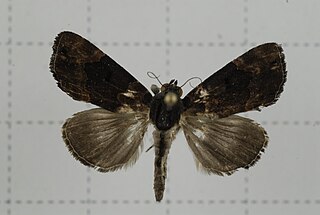
Dinumma placens is a moth of the family Erebidae first described by Francis Walker in 1858. It is found in the Indian sub-region, Sri Lanka, Thailand, China, Taiwan and Japan.
Chorodna strixaria is a moth of the family Geometridae first described by Achille Guenée in 1858. It is found in India, Vietnam, Sulawesi, the Philippines, the Moluccas, New Guinea, Australia and Sri Lanka.
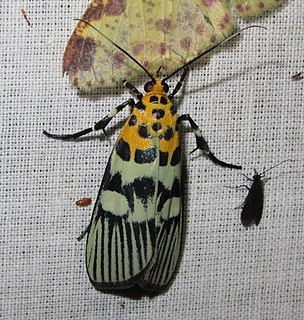
Vitessa suradeva is a moth of the family Pyralidae. It is found in India, Bangladesh, Myanmar, Thailand, Vietnam and Sri Lanka.
Trisula variegata is a moth of the family Noctuidae first described by Frederic Moore in 1858. It is found in India, Sri Lanka, Nepal, Thailand, South China, Indonesia and the Philippines.

Anuga multiplicans is a moth of the family Noctuidae first described by Francis Walker in 1858. It is found in India, Sri Lanka, Hong Kong, Korea, Taiwan, Philippines and Borneo.
Banisia lobata is a moth of the family Thyrididae first described by Frederic Moore in 1882. It is found in India, Sri Lanka, Malaysia, China, Hong Kong and Brunei.












